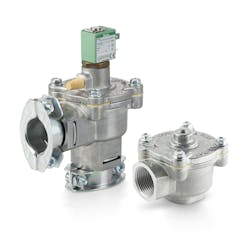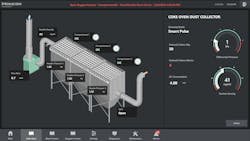Unlocking new levels of dust collection efficiency with smarter monitoring and control
Key takeaways:
- Real-time dust collection system monitoring eliminates blind spots that can lead to premature filter failure, excessive energy consumption, decreased system availability, or unplanned maintenance.
- Dust collection system sensors can monitor everything from particulate thresholds and filter health to blower motor current draw and pressure differentials.
- Facilities can adopt digitalization in stages, targeting the areas with the most immediate impact first.
In manufacturing environments that process dry powders or bulk solids, effective dust collection is not just good practice, it is critical for maintaining workplace safety and operational efficiency. These systems help prevent the dangerous buildup of particulate matter, protect employee health, and support compliance with environmental and safety regulations.
As industrial demands grow and experienced workers retire, facilities are often expected to increase throughput without proportionally upgrading supporting systems, such as dust collectors. This imbalance can lead to performance bottlenecks, unexpected downtime, and even safety risks.
To address these challenges, facilities are increasingly adopting integrated monitoring and control solutions. These systems typically combine field sensors, particularly dust concentration and pressure sensors, with HMI/SCADA interfaces and utilize advanced algorithms to oversee dust collection processes, helping to optimize performance, detect issues early, and maintain compliance across various operational scales.
Digitalizing industrial dust collection
Facilities are turning to digitalization to optimize dust collection processes and improve overall plant performance. While traditional systems offer limited visibility, modern digital tools provide real-time insights into system health, enabling data-driven decisions and timely interventions.
In many facilities, the absence of real-time monitoring creates blind spots that can lead to premature filter failure, excessive energy consumption, decreased system availability, or unplanned maintenance. For example, when solenoid coils or valve diaphragms fail undetected, it may cause inconsistent pulsing or complete cleaning failure. Similarly, broken filter bags can go unnoticed and outdated cleaning logic may cause pulse valves to fire unnecessarily, wasting compressed air and shortening the life of system components.
Digital transformation empowers facilities to shift from reactive to proactive maintenance strategies. Smart sensors, edge devices, and cloud-connected software work together to collect, analyze, and visualize data across dust collection systems, helping operators gain the visibility needed to maintain optimal performance.
This approach to dust collection modernization follows the proven “See-Decide-Act” methodology:
- See: Sensors embedded throughout the system measure key parameters — such as particulate concentration, air temperature, and differential pressure across filters — in real time.
- Decide: Edge computing hardware aggregates this sensor data and sends it to analytics software that interprets the data into trends, benchmarks, and performance diagnostics. Through intuitive dashboards, operators can quickly identify issues, compare system performance over time, and make informed decisions.
- Act: The system sends actionable alerts to maintenance personnel with specific recommendations, such as which filters need replacement or which valves require servicing. This not only streamlines maintenance but also extends component lifespan and reduces downtime.
Smarter data for smarter dust collection system control
High-quality data is the foundation for intelligent automation. In dust collection systems, sensors can monitor everything from particulate thresholds and filter health to blower motor current draw and pressure differentials. When analyzed correctly, this information reveals early warning signs, such as spikes in particle levels indicating a torn filter bag or signs of rising resistance that may suggest clogs or blockages.
One major area for optimization is pulse-jet cleaning. In conventional systems, pulsing is often based on preset timers, regardless of whether cleaning is needed. This results in wasted compressed air, reduced component life, and higher operational costs.
By integrating real-time particulate monitoring with adaptive control logic, modern systems can adjust pulsing frequency based on actual filter conditions. This ensures that filters are only cleaned when necessary, helping to reduce compressed-air consumption and extend the lifespan of both filters and pulse valves.
Compressed-air losses are another major drain on efficiency. Studies have shown that up to one-third of a plant’s compressed air can be lost to undetected leaks. Relying on scheduled manual inspections often allows leaks to persist unnoticed, wasting energy and increasing operational costs.
Sensor-based monitoring systems can continuously track pneumatic airflow to detect leaks early. Real-time alerts enable operators to respond promptly, helping to prevent minor issues from escalating into major problems. Additionally, some systems can localize leaks to specific rows or sections of a dust collector, allowing for more targeted and efficient maintenance.
This kind of predictive maintenance — enabled by edge analytics and intelligent alerts — not only reduces air loss but also minimizes unplanned downtime and lowers labor costs associated with manual inspections.
The same intelligent monitoring that improves day-to-day operation also streamlines maintenance workflows. When a filter or valve nears the end of its lifecycle, the system can generate a notification, trigger a part reorder, and help schedule replacement, ensuring that service happens exactly when and where it is needed.
The result is a maintenance strategy that delivers maximum value with minimal disruption. Operators no longer need to manually check every filter or valve, mostly relying on experience. Instead, they are guided by real-time data, allowing them to focus resources where they matter most.
While some facilities may initially hesitate to invest in digital enhancements, the long-term ROI is significant. Reduced energy consumption, longer component life, and fewer unplanned outages quickly add up to meaningful savings. And because this solution is modular, facilities can adopt digitalization in stages, targeting the areas with the most immediate impact first.
A scalable, integrated solution to modernizing dust collection
Efficient dust collection requires more than just reliable hardware, it depends on a cohesive system that integrates sensing, control, and analytics. Modern monitoring and control platforms are increasingly designed to work across both new and existing systems, offering scalability and adaptability to various facility sizes.
One effective modernization strategy involves a “floor-to-cloud” architecture. This integrated monitoring and control solution begins at the plant floor with smart sensors and control devices and extends to cloud-based platforms that provide system-wide visibility and advanced analytics. From real-time dashboards to enterprise-level reporting, such architectures support informed decision-making and long-term performance improvements in dust collection operations. Operators benefit from real-time insights into system behavior, while corporate teams can track trends across facilities to drive continuous improvement. Alerts related to compressed-air usage, filter efficiency, or early warning signs of failure enable proactive decision-making at every level.
Modern dust collection systems are becoming more compact, automated, and data driven. By embracing intelligent automation, facilities can dramatically improve system efficiency, safety, and sustainability. With an end-to-end pre-engineered solution embedding state-of-the-art algorithms and logics, companies gain the tools to transform dust collection from a maintenance challenge into a performance asset, enhancing regulatory compliance, protecting workers, and boosting overall productivity.
About the Author

Samuele Oliva
Samuele Oliva is product marketing manager, Dust Collection Systems and Alternative Energy, Discrete Automation Group, Emerson.


